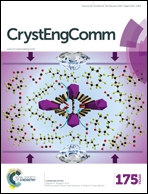In situ synthesis of porous ZnO-embedded Zn1−xCdxS/CdS heterostructures for enhanced photocatalytic activity†
Abstract
The in situ synthesis of ZnO-embedded Zn1−xCdxS/CdS heterostructure nanocrystals was achieved by using a simple surfactant-free hydrothermal route. The morphology and the exposed active site content of Zn1−xCdxS/CdS could be facilely modulated by varying the particle size of ZnS precursors, and the heterostructure with the smallest particle size showed the highest photocatalytic activity of 22.99 mmol h−1 g−1 in Na2S + Na2SO3 solution. Furthermore, the in situ embedding of the ZnO cocatalyst on the Zn1−xCdxS/CdS heterostructure dramatically improved its photocatalytic activity to 84.17 mmol h−1 g−1, which is 765 times higher than that of CdS prepared by a hydrothermal method. More significantly, the ZnO-embedded Zn1−xCdxS/CdS heterostructure gave a considerable H2 production rate even in the absence of hole scavengers, whereas the bare Zn1−xCdxS/CdS exhibited no hydrogen evolution, and it showed very competitive photocatalytic activity in methanol in comparison with that in Na2S + Na2SO3 solution under similar alkaline circumstances. These investigations indicate that the existence of the ZnO cocatalyst in the heterostructure could not only effectively improve the photocatalytic activity by suppressing the recombination of charge carriers and acting as a photocatalytic reaction site, but also make it possible to adopt methanol as the sacrificial reagent for sulfide photocatalysts.


 Please wait while we load your content...
Please wait while we load your content...